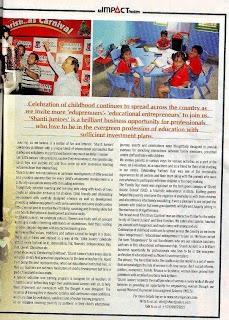
SAFE WATER PLAY
Children of all ages enjoy playing in water. If you have a swimming pool in your yard, it is absolutely necessary that adults supervise children in or near the pool. Even small wading pools can be dangerous for small children.
A wading pool with only a small amount of water in it is potentially dangerous. It takes only a few minutes and less than an inch of water for a young child to drown, given the right circumstances.
Small pools and wading pools should always be emptied when not in use.
Larger pools (in-ground and above-ground) should be fenced in and the gate kept locked when the pool is not in use.
Beware of young children playing in buckets of water without adult supervision. It is easy for children to fall into a bucket and drown.
Children can have fun with water play, but adults must be willing to spend the time to insure the safety of children playing in or near water.
WET AND WILD ACTIVITIES
"PAINTING"
Give each child a small bucket or can with water in it and an old paintbrush. Children enjoy "painting" the house, steps, garage, fence, sidewalk, etc. using their own bucket and brush.
GARDEN SPRINKLER
Instead of playing in a pool, attach the garden hose to a sprinkler. Turn on the water and listen to the squeals of delight as the children run through the spray of water.
BALLOON CATCH
Fill small balloons with water, and use them to play a game of catch with
the children.
WATER PLAY ACCESSORIES
Simple household items can make water play a lot of fun. See if you have any of these items for the children to play with:
muffin tins
sieve
measuring spoons
funnels
measuring cups
strainer
empty plastic bottles
sponges
empty squeeze bottles
corks
WET SAND
Wet some sand in a sandbox. Talk about the differences between the wet and dry sand. Have the children dig rivers, streams, and lakes in the sand, and fill them with water.
PING PONG BOATS
Use clean, empty margarine tubs for boats. Float the boats in a wading pool or dishpan. Have each child take turns trying to toss ping-pong balls into the boats.
SAILBOAT
Need:
clean styrofoam meat tray
crayons
construction paper
stapler
pipe cleaner
To Do:
Have each child use crayons to decorate the styrofoam meat tray. Stick the pipe cleaner through the center of the tray. Secure it by bending the end on the underside of the styrofoam tray. Cut a small diamond shape out of the construction paper. Fold the diamond in half to make a sail. Place the pipe cleaner in the fold of the sail and staple to hold it in place. Take the sailboat outside for a voyage in a wading pool or dishpan.
SINK OR FLOAT
Have each child gather a number of items from around the house (such as a paper clip, sponge, cork, plastic toys, marble, etc.). Take them outside to a wading pool, dishpan, or bucket of water to see which items sink or float.
Try some experiments with the children. Can you make something that sinks, float? Place a sinking object on a floating object. For example, place a marble on a sponge. What object holds the most things and still floats?
BUBBLE BLOWING
Blowing bubbles is a fun outdoor activity for all ages. Children who are 2 -1/2 years old and older can learn to blow bubbles if you show them how.
An easy bubble solution can be made from:
1/2 cup hand dishwashing liquid
5 cups water
A tiny bit of cooking oil added to the soap and water mixture will make the bubbles tough enough to float in the air without breaking easily.
You can buy bubble wands and pipes at a store or try any of these:
plastic berry basket bottoms (dip in bubble solution and wave in the air)
thread spools (dip one end in bubble solution and blow through opposite end)
plastic drinking straw (dip one end in bubble solution and blow through opposite end)



